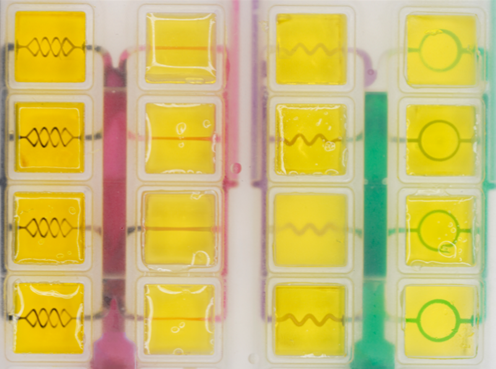3D Systems Spins off Bioprinting Startup Systemic Bio
After venturing deeply into the bioprinting space, 3D Systems (NYSE: DDD) is shifting gears by spinning out its assets in this sector into a new, wholly owned company: Systemic Bio. The new biotech firm will leverage 3D Systems bioprinting technologies, including that capable of producing fully vascularized organ models, to target pharmaceutical discovery and development.
3D Systems Enters Bioprinting
In January 2021, 3D Systems surprised the world with the development of a fully vascularized human lung model. The organ, created through a partnership with United Therapeutics (NASDAQ: UTHR), relied on 3D Systems’ Figure 4 continuous digital light processing (DLP) technology to 3D print the scaffold for the model. The resulting structure was then cultured with stem cells, allowing for its maturation into a vascularized lung model. Altogether, this technique was dubbed Print to Perfusion.
The company then pushed further into bioprinting with the acquisitions of desktop bioprinter manufacturer Allevi and tissue bioprinting startup Volumetric. These developments were surprising due to the fact that 3D Systems, like most 3D printer manufacturers, seemed to be focused on industrial additive manufacturing (AM) applications. Now, it seems to be dividing its assets in a logical way by spinning out those related to pharmaceutical research into a new company.
From Allevi to Systemic Bio
 To kickstart Systemic Bio, 3D Systems is providing $15 million in seed funding, meant to support the business through its startup phase. Due to the maturity of the firm’s materials and process technology, 3D Systems believes that this will be sufficient to aid Systemic Bio as it reaches material revenue level and profitability. Meanwhile, 3D Systems will gain greater access to the pharmaceutical market, through which it hopes to achieve $100 million in biotech revenue over the course of the next five years.
To kickstart Systemic Bio, 3D Systems is providing $15 million in seed funding, meant to support the business through its startup phase. Due to the maturity of the firm’s materials and process technology, 3D Systems believes that this will be sufficient to aid Systemic Bio as it reaches material revenue level and profitability. Meanwhile, 3D Systems will gain greater access to the pharmaceutical market, through which it hopes to achieve $100 million in biotech revenue over the course of the next five years.
Leading the team as CEO is Taci Pereira, who served as Chief Scientific Officer of Allevi at the time it was acquired before becoming Vice President and General Manager of Bioprinting for 3D Systems. 3DPrint.com recently published an interview with Pereira where she detailed much of the work that will now fall under the purview of Systemic Bio. She will be speaking at 3DPrint.com’s Additive Manufacturing Strategies February 7-9, 2023, where attendees will likely be able to learn more about her new company.
“As the leader of our Allevi business, Taci brought a unique blend of business acumen and bioprinting expertise that has enabled our continued growth in laboratory solutions,” said Menno Ellis, executive vice president of healthcare solutions at 3D Systems. “Her knowledge, passion, and demonstrated leadership position Taci very well for her new role as CEO of Systemic Bio. I’m confident that the solutions her team delivers can have a transformative impact in the field of pharmaceutical drug discovery and contribute meaningfully to the exciting growth we have envisioned for our healthcare business.”
Bioprinting Organs-on-Chips
Systemic Bio will take Print to Perfusion, as well as its own bioprinting technology, to create highly complex, custom, vascularized tissues for its proprietary organ-on-a-chip platform, human vascularized integrated organ systems (h-VIOS). As discussed in our interview, organ-on-a-chip technology sees plates of vascularized, three-dimensional scaffolds connected to auxiliary equipment, such as pumps, to feed materials, such as drug compounds, into the tissue and study their effects. Unlike synthetic materials, such as silicone, generally used to perform drug discovery research, h-VIOS is able to more accurately reflect the response of human tissue.

Section of an h-VIOS32 plate containing an array of vascularized hydrogels with different architectures.
3D Systems highlights the extreme detail possible with its Print to Perfusion process for organs-on-chips. h-VIOS combines hydrogel bioprinting, seen in many bioprinting platforms, with Print to Perfusion to achieve high-resolution scaffolds that can be seeded with human cells, sick or healthy. As a result, pharmaceutical researchers can isolate the relationships between medications and specific sets of cells. Accurately replicating human tissue for pharmaceutical research has a number of benefits. Not only could such a platform limit reliance on animal testing, but it may also reduce the costs and time-to-market for drug development.
Manufacturing in Texas
The company produces its customized h-VIOS chips using bioprinters at its facility in Houston, Texas, where, according to 3D Systems, its “bioprinters are capable of at least 10x greater build volume and up to 10X higher resolution than other available platforms which enables efficient, production-grade manufacturing.” Systemic Bio is in the process of establishing multi-phase drug discovery partnerships with pharmaceutical companies. In addition to producing organs-on-chips, the firm is also available for contract research services.
In our interview, Pereira pointed out how the legacy of 3D Systems has enabled the bioprinting technologies under her management to evolve to reach production-scale:
“[W]hen you think of a player like 3D Systems—with decades dedicated to developing additive manufacturing solutions—for the first time, you can see all of these developments and technological foundation being applied to bioprinting. And 3D Systems was one of those players that took the technology and used it to solve real problems in different market segments within its Industrial and Healthcare businesses. The company has been able to create and capture tremendous value with that. So, we really see the opportunity for the first time in the bioprinting market to take these research and prototyping ideas through to commercial, production-level solutions.”

h-VIOS2 containing two perfused vascularized hydrogels. Within this chip’s footprint, any vasculature can be created.
In a press release announcing the new company, Dr. Jeffrey Graves, president and CEO of 3D Systems, said, “I am pleased and inspired by the progress we continue to make in the emerging field of regenerative medicine. The complexity and precision that we have now demonstrated using biocompatible materials and our most advanced production bioprinting platform technology is truly groundbreaking, opening a host of new applications ranging from the laboratory to replacement organs within the human body. In forming Systemic Bio we are applying these core technologies to specifically address critical needs within the pharmaceutical market. With our potential to ultimately manufacture hundreds or even thousands of custom-designed, proprietary human tissue models, pharmaceutical companies can more rapidly and accurately evaluate the efficacy of developmental drugs in the laboratory, with the goal of reducing development time and eventually eliminating the need for animal testing. By leveraging the progress we have made on our core bioprinting technologies, we are now in a unique position to create this new business — bringing added value to our shareholders, our employees, and, most importantly, to those in need of new, advanced drug therapies to extend, or improve the quality of their lives.”
As the company establishes select initial partners for its h-VIOS platform, interested parties can visit the Systemic Bio website for more information. Given the new development, one wonders if, when its bioprinted tissue products for regenerative medicine will result in yet another spin-off. Perhaps, the remaining bioprinting assets, mainly those related to Volumetric, will see a merger with United Therapeutics to establish the first company that can successfully produce tissues and organs for therapeutic purposes.
All images courtesy of 3D Systems.
Subscribe to Our Email Newsletter
Stay up-to-date on all the latest news from the 3D printing industry and receive information and offers from third party vendors.
Print Services
Upload your 3D Models and get them printed quickly and efficiently.
You May Also Like
Daring AM: 3D Printing Antennas, Factories, and Rockets in Space
From 3D printed antennas rising 100,000 feet above Earth to futuristic orbital factories and metal parts made in space, 3D printing is reshaping how we build for space. In three...
New Tech Transmits 3D Printing Granules in Microgravity
Researchers from the University of Glasgow have secured a patent for an in-space microgravity 3D printing technology. The patented invention employs a conveyor-based system to transport granulate material for fused...
Flexibility Is the Bottom Line: Touring the Visitech Americas DLP Light Engine Factory
Visitech, a leader in optics for digital light processing (DLP) and powder bed fusion (PBF), recently expanded its footprint in the U.S. with a new factory in Allen, Texas. This...
3devo’s Filament Maker TWO Advances Custom 3D Printing Filament Production
The Dutch firm 3devo has been producing compact filament makers for several years, establishing their devices as mainstays for polymer and filament companies worldwide. The 3devo machines enable these companies...






























